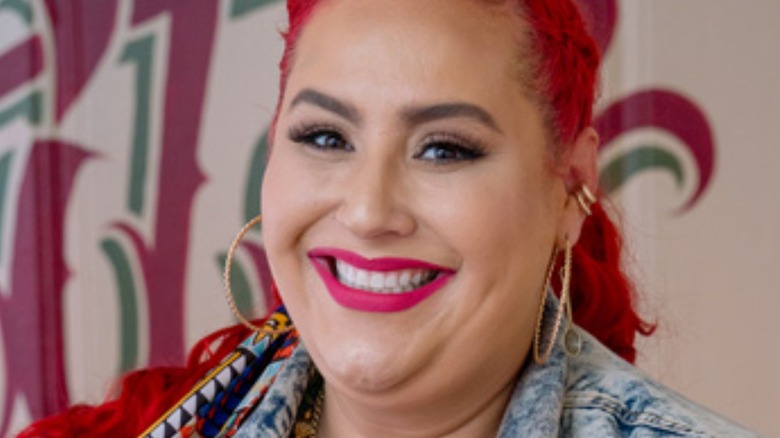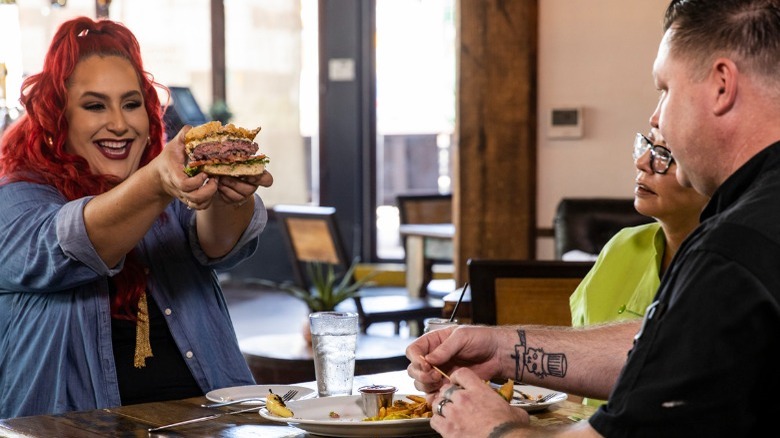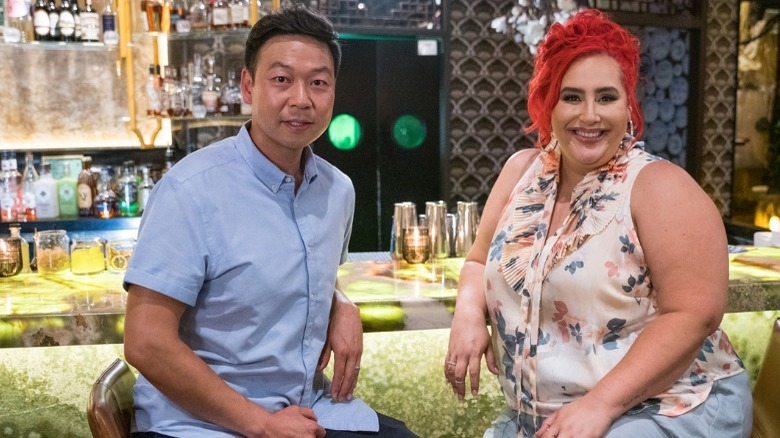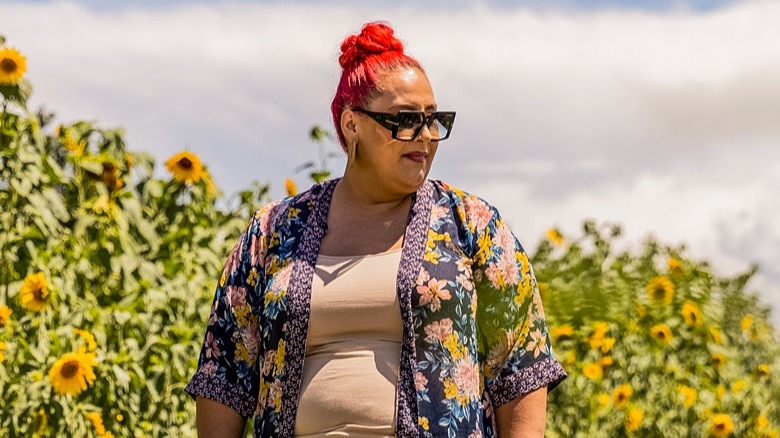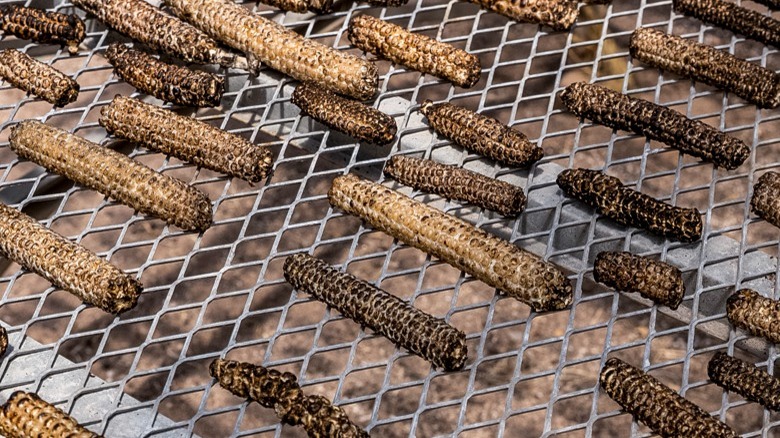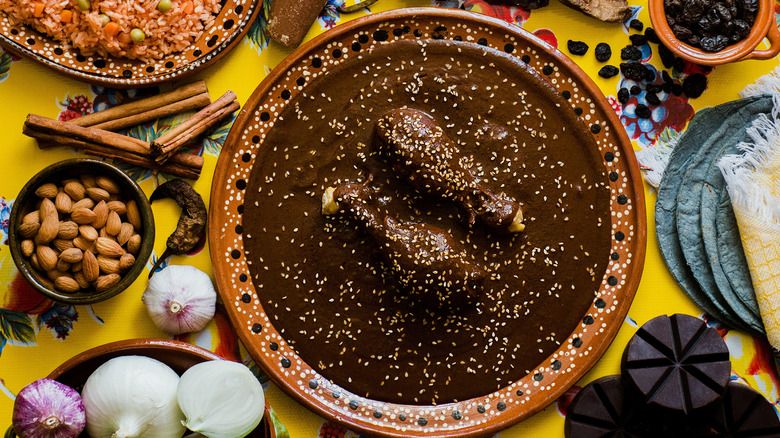MasterChef Winner Claudia Sandoval On Taste Of The Border, Regional Foods, And Perfect Mole - Exclusive Interview
For the appetizer segment in the "MasterChef" Season 6 finale – which aired in 2015 – Claudia Sandoval presented Gordon Ramsay with a Mexican truffle-infused tamale. "I served him something that my ancestors would've served to the gods," Sandoval explained to Mashed. Ramsay didn't see it that way at first, but regardless, in 2017, the "MasterChef" champion was tapped as a judge for "MasterChef Latino." She wanted to be on the show — as she told Latino Review Media – to showcase Latino culture and gastronomy.
This is what Sandoval calls her "culinary voice": Elevating traditional recipes and carving out a place for them within a food culture that often minimizes the importance and richness of Latin American and border foods. Sandoval's newest endeavor, a Discovery+ special called "Taste of the Border," is a vibrant celebration of her culinary raison d'être. Over four episodes, she journeys from border town to border town, sampling hidden food treasures and uncovering what she calls a "food revolution" made up of Pan Asian hot chicken, chilaquiles, bone marrow tacos, and Sonoran hot dogs.
In this exclusive interview with Mashed, Sandoval shares the foods and places that astounded her while filming "Taste Of The Border," as well as revealing her "Master Chef" memories — and even divulges the secret to mastering mole.
The border region that Claudia Sandoval found most surprising
You grew up going back and forth across the border, so you must have had some expectations going into this journey. What surprised you?
Oh my God. Everything. When you live in a specific place, you know what to expect from that region. ... I guess I'm like every other American [where] we think that everything is the way that we see it. I thought that everywhere else on the border would be pretty much the same thing. You're going to have the same kind of foods and the same kind of diversity. And it was nothing alike, which was fascinating.
One of the most fascinating [places] for me was New Mexico. I guess in my head, when I think of New Mexico, I pair it with Arizona, and [assume], "Oh, it's all the desert." But New Mexico was mountainous and green everywhere and [there were] plantations everywhere. And I [thought], "What? What is happening?" It just changed my whole perspective about regions, about who [lives] where. Because there was also a very large indigenous population in Arizona and in New Mexico, which I had no idea about. And there's a lot of influences there. ... Much like everyone watching "Taste of the Border," it's going to be really, really surprising with the incredible amount of diversity [that it showcases]. But also, it's going to change perspectives about what you think in your head [of those regions] because of what you've been taught. In books, New Mexico is a desert. Then you go there, and you'll [say], "This is not a desert."
Claudia Sandoval on Mexicali's unexpected culinary gems
Take us beyond the food stereotypes we have of the [border region]. We have a lot of Tex-Mex food stereotypes that tell us [that border food] is burritos, tacos, enchiladas — that's the stereotype of easy, cheap Tex-Mex-Mexican food. What food should we be paying more attention to?
Well, I don't know that there's something that we should be paying more attention to. But one of the things that you'll be really surprised about that [maybe] a lot of people don't know [is in] Mexicali ... [which] is just about one-and-a-half hours east of San Diego, just south of the border of Calexico, California, in the Imperial Valley. They have the largest number of Chinese-Mexican restaurants. Chinese! I know that there are Chinese restaurants everywhere, but [most regions] don't have 200-plus!
And that's because there was a huge migration of Chinese people that had come to build the railroads in the United States. And then later, they had to move out because of the Chinese Exclusion Act. ... I didn't realize that [those food offerings were] so tied to that history. But then, once I was there and we were eating at one of my favorite Chinese restaurants, [I was told], "Did you also know that there's underground tunnels in this China town?" ... Because of prohibition in the United States, people used to come to Mexicali, and it was the Vegas before there was Vegas!
It was just fascinating. Those types of stories are ones that really start to change your perspective of what you consider a border town. To your point, when we think of a border town, if it's San Diego ... you're thinking more Baja cuisine. But then Arizona and New Mexico, we think: Southwestern food. And then once you're on the Texas border, it's Tex-Mex, right? Those are the clichés, but you're going to find that it's not completely true. And that's what I love about this show.
Claudia Sandoval on finding her culinary voice
In your work, you've been very proud of using local ingredients and traditionally Mexican ingredients. You made tamales in the "MasterChef" finale, and Gordon Ramsay said, "What is this?" What went into that decision?
We actually touch on that in Episode 4 [of "Taste Of The Border"] because in Episode 4 we visit some more fine dining, if you will, more modern technique food. I was at Koli Restaurant in Monterrey, and one of the things that we talked about was this idea of you can't move forward until you look back, and really honoring roots before you're able to move forward [with food].
I found that so fascinating because that's my culinary voice. When I think of myself as a chef and what I want to portray through my food, I want to respect the recipes and the flavors and the ingredients that are used in those very traditional [dishes], but present them in a way that they look a little bit more elevated, a little bit more modern, a little bit more — whatever you want to call it. But when you taste it, it's going to taste like exactly what my grandma would've fed you.
That's really what I wanted to do. [In the "MasterChef" finale], Gordon Ramsay said ... "Why in the finale, with some of the most expensive ingredients, would you serve me a tamale that I could get out of the back of a truck for three dollars?" But, in my opinion, he also doesn't know the history of our food.
Claudia Sandoval talks about that 'MasterChef' finale
What is that history?
Maíz [corn] used to be money. It used to be the most expensive amount of currency with ... the Aztecs, the Mayans, the Olmecas, and Toltecs. So maíz was critically important.
In fact, when tamales were first made, they were an offering to the gods. So I know that, to Gordon Ramsay, [tamales didn't have that worth], because of the way that Mexican food has been portrayed in the United States. ... It has been presented as of little value. But cultural food, Colombian food, Mexican food, South American food, Central American food, and really food from all over the world is incredibly valuable.
And when we look at some of the history behind our food ... Think about it, I served him something that my ancestors would've served to the gods. How much more respectful could I have been? ... I stand by what I said to him that day: "I'm never going to shy away from my culture and from my roots and from portraying that in the best way that I can." And if I can change his mind, that a tamale can be worthy of one of the best cooking competitions in the world, then I've done my job.
That's exactly what I'm hoping to do through this new show, to [demonstrate] that these border regions aren't just ... Let's stop reducing them to the two minutes that you hear on the news that is bad, that is all about crime, that is all about the bad things that are happening at the border. Because the borders are also full of incredible people like me, like the chefs that I know, and like all of the incredible people that I met on this show [while] filming it. [They] are not only making a name for themselves but [also] for their communities, for their culture. And [they] are really changing the perspective of people [on the border] and [those regions are] blowing up and [those people are] creating this amazing food revolution, that few people are really ... privy to. That now, unfortunately, I'm exposing.
How to master mole sauce, according to Claudia Sandoval
We have one final question for you. The art of making mole, which can have 43-plus ingredients — how do you master that art? And after you master a sauce like that, can you master anything?
The thing with mole is ... my biggest advice to anybody [reading] ... is that mole is a labor of love. You cannot rush the process. My mole is about 37 ingredients. It's not 43, but it's close. But it takes me three days to get through the majority of just processing the ingredients, not even getting it all together. Toasting, frying, separating, [and] cleaning all of the ingredients ... it's a three-day process.
Mole isn't just a sauce that can be made in 15 minutes. I see it done on these shows ... [and] I'm like, "Well, that's not really mole." Because mole traditionally is very, very important. The biggest thing is balance. And I know that sounds silly when you're talking about that many ingredients, but as you continue to learn, as you continue to make mole, the more you make, the more you're going to feel, "Oh, I need to take it back a little bit on the sesame seeds. And I need a little bit more plátano maduro [ripe plantains], or I need more cacao beans, or I need more raisins, or I need more tomato or whatever."
That's the other thing. There are over 300 types of moles, and all of them are different. So don't try to limit yourself to, "Oh, well, this isn't like the mole that I tried in Puebla or Oaxaca or Guatemala," or wherever. Mole is really what you want to make it. It's really your opportunity to create something that speaks to you, to who you are, and to what you like.
Maybe you like a very fruit-forward mole that is mostly focused on bananas and mangoes and things like that. But there are other people who are like, "No, I want it based on herbs," which is why you have green moles that use things like parsley and all of those types of ingredients. So, I think mole is a dance, and mole is a thing of balance, and it's really about finding your voice through your sauce. And yes, it's a labor of love and you have to be patient, but have faith. I'm sure you can nail it.
Follow Claudia Sandoval as she discovers how the food from border towns — from San Diego, California to South Padre Island, Texas — showcase a blending of flavors and cultures from the US and Mexico as well as other unexpected influences. All episodes of "Taste of the Border" are now available on Discovery+.
This interview has been edited for clarity.
